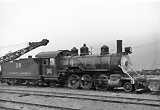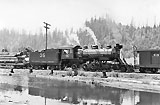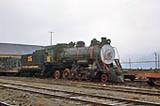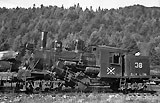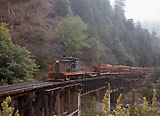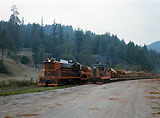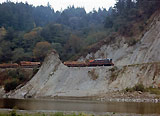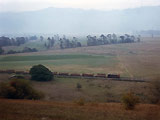|
|
|||||||||||||||||||||||||||||||||||||||||||||||||||||||||||||||||||||||||||||||||||
|
The Pacific Lumber Company
|
Introduction First off, let me give credit where credit is due. Most of this information is from the book Steam in the Redwoods by Lynwood Carranco and Henry Sorenson. Both are Humboldt County natives; Lynwood was born and raised in Samoa, CA, and he became Professor Emeritus of English at College of the Redwoods in Eureka; Henry was born and raised in Arcata, and he worked on the Hammond Lumber Company railroad that used to run from Samoa through McKinleyville to Crannell, and thence into the woods from there. Henry went into the army during the second world war and quickly ended up in the railroad operations arm of the forces invading France , quickly becoming an assistant road foreman of engines. Following the war he returned to Humboldt County only to find that a forest fire had wiped out the Hammond Lumber Company logging railroad beyond Crannell and that the railroad jobs were no longer there (the balance of the Hammond System, Crannell to Samoa, stayed in operation until 1961, when it was finally abolished in favor of trucks; however, Henry did not have enough seniority to return to work on what was left of the system). Henry settled down to the dairy and chicken business of 40 acres that he owned in McKinleyville, and set out to build a narrow gauge railroad on his property. This he did, eventually ending up with two active steam locomotives (one native to Humboldt County, another a former logging railroad engine from Japan ). Both of these locomotives were on display at CSRM in Sacramento last I knew. |
||||||||||||||||||||||||||||||||||||||||||||||||||||||||||||||||||||||||||||||||||
 Steam Locomotives |
|||||||||||||||||||||||||||||||||||||||||||||||||||||||||||||||||||||||||||||||||||
#1- Baldwin 2-4-2T, 1886, c/n 8007. Was later re-# to #23. Wrecked and scrapped 1938. #2- Baldwin 2-4-2T, 1887, c/n 8792. Later became #22. #3- ? 4-4-0, circa 1886. Purchased in 1898; sold 1903. Eventually ended up on NWP; scrapped 1931. #3 (2 nd) Baldwin 2-6-2, 1922, c/n55248. Originally built for Humboldt Northern Railroad (Dolbeer & Carson Lumber Company). To TPLCo 1950; to Stockton Terminal & Eastern 1953. Update: There seems to be some uncertainty over whether or not this was "truly" at TPL locomotive or not. What's not in question is that TPL bought the Dolbeer & Carson Lumber Company in 1950, and that the D&C continued operating under apparently its own banner until 1953 when TPL completed truck roads allowing logs from the area tributary to the old D&C railroad to be trucked over the hill to reloads on TPL's Yager Creek railroad. All appearances are that TPL owned this locomotive indirectly through the D&C company from 1950-1953, I have seen no evidence it was ever officially on the TPL roster, or lettered for TPL. Otherwise, this locomotive belonged to the Humboldt Northern Railroad from construction until 1930/1931, then D&C until 1953. The ST&E donated the locomotive to CSRM, who held it until 2008 when they conveyed it to Timber Heritage Association. It has since been moved back to Humboldt County and is now in the old Hammond roundhouse in Samoa with the rest of the THA collection. One last note of interest, the #3 has carried since 1955 the tender from the McCloud River #21, the ST&E arranged to swap the original tender from the #3 with the MR 21 while the #21 was passing through Stockton en route to the scrapper. #19- Baldwin 0-6-0T, 1875, c/n 3739. Worked for D.R. Jones & Company (South Bay Railroad & Land Company), Humboldt Bay Logging Railroad, and Excelsior Redwood Company before coming to TPLCo. Year unknown. Later went on to Buhne, Jones & Company Railroad before disappearing from records. #20- Marshutz & Cantrell 0-6-0T, 1882. Came from same ownership line as the #19. Received a tender while on TPLCo. Disposition un-recorded. #21- Rogers 4-4-0, 1881. Initially #1 upon arrival at Scotia; later re-numbered #21. #5, Baldwin 2-4-2T, 1904, c/n 24317. Renumbered #25; sold to Homes-Eureka Lumber Company. #26, Lima 2-Truck Shay, 1906, c/n 1615. Scrapped 1950. #27, Baldwin 2-6-2, 1909, c/n 33339. Scrapped 1955. #28, Lima 2T Shay, 1910, c/n 2268. To Pelican Bay Lumber Company ( Algoma, Oregon), then to Pelican Pine Mfg. Co., Pelican City , OR . #29, Baldwin 2-6-2, 1910, c/n 34484. Purchased new; donated to NCLIA in 1986 (see note 2). #30, Baldwin 2-6-2, 1911, c/n 36173. Purchased new; scrapped at Scotia 1955. #31, Lima 3-Truck Shay, 1911, c/n 2419. Built as a demonstrator for a dealer in San Francisco ; to California Western Railroad & Navigation Co. #10; to TPLCo #31; to Boise Payette Lumber Company #4 (Centerville, ID); to USA Corps of Engineers, Fort Peck Dam Railroad, Fort Peck, Montana in January 1920. #32, Porter 0-6-0, 1920, c/n 6533. Fireless steam locomotive (ran on steam provided by sawmill). Proved unsuccessful, was sold to Santa Fe Tie & Timber Preserving Company in 1921. #33, 3T Climax, 1921, c/n 1592. Returned to builder. Update: Longer history behind the 1st #33 is that after acquiring it TPL apparently decided they wanted something with superheat and piston valves and so in 1923 they sent it back to Climax in exchange for the 2nd #33. Climax resold the #33:1 to Buffelen Lumber & Manufacturing Company #4, Eagle Gorge, Washington, who conveyed it around 1936 to Lindberg & Hobi Company #4, Mineral, Washington. #33 (2 nd), 3T Climax, 1923, c/n 1633. Scrapped 1952. Update: See above for reasons behind their purchase of the 2nd #33. Sometime in the middle to later 1940s the #33 was working on the Jordan Creek operations on the west side of the Eel five or six miles south of Scotia when the bridge connecting that line with the NWP main washed out. TPL apparently didn't need the #33 anywhere else bad enough to retrieve it, so it spent several years sitting in the old Jordan Creek camp with other marooned equipment until TPL finally cut it up in 1952. #34, Baldwin 2-6-0, 1913, c/n 39760. Purchased 1921 from Ocean Shore Railroad; sold 1942 to Red River Lumber Company (Westwood , CA ); to Fruit Growers Supply Company 1944; Scrapped at Westwood 1953. #35, Baldwin 2-8-2, 1924, c/n 67538. Sold to a couple private individuals, but never left Scotia; 1971 re-sold to Heber Creeper Railroad in Heber City , UT. Now in the collection of the Nevada State Railroad Museum in Boulder City, NV and is available for sale. Update: Any thoughts NSRM may have had about selling this locomotive appear to have passed as they have since cosmetically restored it and placed it on display as "Nevada Southern Railway #35". #36- Lima 2T Shay, 1907, c/n 1836. Purchased 1935 from Metropolitan Redwood Lumber Company; Scrapped 1953. #37- Alco 2-8-2T, 1924, c/n 660333. Purchased 1935 from Sugar Pine Lumber Company; sold to a private individual, who re-sold it to another private individual in Pennsylvania (see THA Update) . Locomotive left Scotia December 1966. Update from Timber Heritage Association website: "[R]etired in 1956. Sold to a local private party in 1962, it remained in Scotia until it was sold again in 1966 to a Pennsylvania tourist line where it operated in 1968. After that line closed, No. 37 was purchased by another private party and moved to Wilmington, Delaware. There it was overhauled and began operating on the Wilmington & Western Railroad pulling excursion trains from 1987 to 1990. The lease ended when a dispute arose between the owners and the railroad thus making it available for THA to purchase." Per Moore: By 2009 moved to Strasburg Strasburg Railroad Shops for restoration. #38- 2T Climax, 1922, c/n 1621. Purchased 1938 from Holmes-Eureka Lumber Company; to private individual in Willits , CA 1956; still in the Willits area as part of Roots of Motive Power collection.. Update: Bert Rudolph was the private individual who bought the #38 in 1956. In 1990 Roots of Motive Power acquired it and is presently restoring the #38 to operation. #1 (2 nd or 3 rd ) 2T Shay, 1907, c/n 1952. Purchased 1942 from Hammond & Little River Railroad for use as a parts source. Scrapped 1950. #9- 2T Heisler, 1921, c/n 1446. Built as Mt. Tamalpais & Muir Woods #9, to Siskiyou Lumber Co. #1, to Dolbeer & Carson Lumber Company #5, to TPLCo 1950; placed on display in front of TPLCo headquarters in Scotia 1953; re-numbered #9 1956. Still on display in Scotia. Update: There is much confusion and contradictory records as to the status of this locomotive in the 1953-1956 time frame. As per one source (Ferroequinologist article written by Bog Johnson and Jack Gibson and republished in the February 1954 Western Railroader) the locomotive had been sold around 1953 and perhaps earlier to a contractor who planned to convert the boiler to a hot plant. Complicating that is some surviving correspondence between Trains Magazine and Ted Wurm from late 1952/early 1953 in which Ted initially reports a fundraising effort amongst the citizens of Mill Valley to buy the locomotive and bring it "home", but by April 1953 that effort had failed and Ted reported the locomotive was likely to be scrapped soon. Finally, the 1 September 1956 issue of The Humboldt Times carried a story about the locomotive being placed on its display track in Scotia the previous Thursday (suggesting 30 August 1956), the text of the article quotes a TPL official as stating the company had owned the locomotive since they had bought the Dolbeer & Carson company in 1950. Taken together, the evidence SUGGESTS that D&C/TPL sold the locomotive to the hot plant operator sometime in early 1953 after the original fundraising efforts by Mill Valley residents fell apart, then TPL repurchased the locomotive sometime in the 1953-1955 time frame (5 October 1953 as per at least one source) specifically to display it in Scotia. Lastly, it was not displayed in front of TPL headquarters but instead next to what had been the bank building in town that TPL subsequently developed into its historical museum, and at some point after placing it on display renumbered it to #9, obviously in honor of its roots on the MT&MW as that was the only time the locomotive had carried that number. Finally, the biggest update is that the Scotia Community Services District, which inherited the #9 along with all other Scotia utilities and infrastructure following TPL's demise, sold the #9 at auction to the "Friends of the #9", which in November 2018 trucked it back south to some private property in Sonoma County. They are in the process of doing at least a cosmetic restoration and are looking for a public display place either in Mill Valley or somewhere on Mt. Tamalpais. |
|
||||||||||||||||||||||||||||||||||||||||||||||||||||||||||||||||||||||||||||||||||
 Diesel Locomotives |
|||||||||||||||||||||||||||||||||||||||||||||||||||||||||||||||||||||||||||||||||||
| #101- GE 80-ton, 1956, c/n 32395. Purchased new? Retired 1992, sold 1996 to Dick Samuels (Oregon Pacific Railroad) Milwaukee , OR . #102- GE 80-ton, 1956, c/n 32413. Purchased new? Retired 1992, sold 1996 to Dick Samuels (Oregon Pacific Railroad) Milwaukie , OR . Joint Update #101-102: TPL definitely purchased all three 80-tonners new. Oregon Pacific leased the #102 to Columbia Business Center in Vancouver, Washington, in 1995 and then sold it to them in 1997, and scrapped the #101 in Milwaukie in the spring of 2014. #103- GE 80-ton, 1957, c/n 32414. Purchased new? Sold 1980 to Cerveceria Moctexuma Brewery, Vera Cruz, Mexico . #104- Baldwin VO-1000, 1945, c/n 71740. Built for US Army Transportation Corps.; to TPLCo 1962; to Keota-Washington Transportation #104, Iowa Falls , Iowa 11-1981.) #105- Baldwin VO-1000, 1945, c/n 71985. Built for US Navy; to TPLCo 1964; to Keota-Washington Transportation #105, Iowa Falls , Iowa , 1981. Update from Wx4: Keota-Washington Transportation Co. purchased a Rock Island branch line after the latter quit in 1980. It operated the line on an "as-needed" basis until it failed in 1988. The units were not repainted and it is unclear if they ever operated on the line. A lineside grain elevator company purchased the two units as part of an attempt to buy the railroad, but they were scarpped after the sale never materialized. The right of way is now the Kewash Trail. |
|
||||||||||||||||||||||||||||||||||||||||||||||||||||||||||||||||||||||||||||||||||




